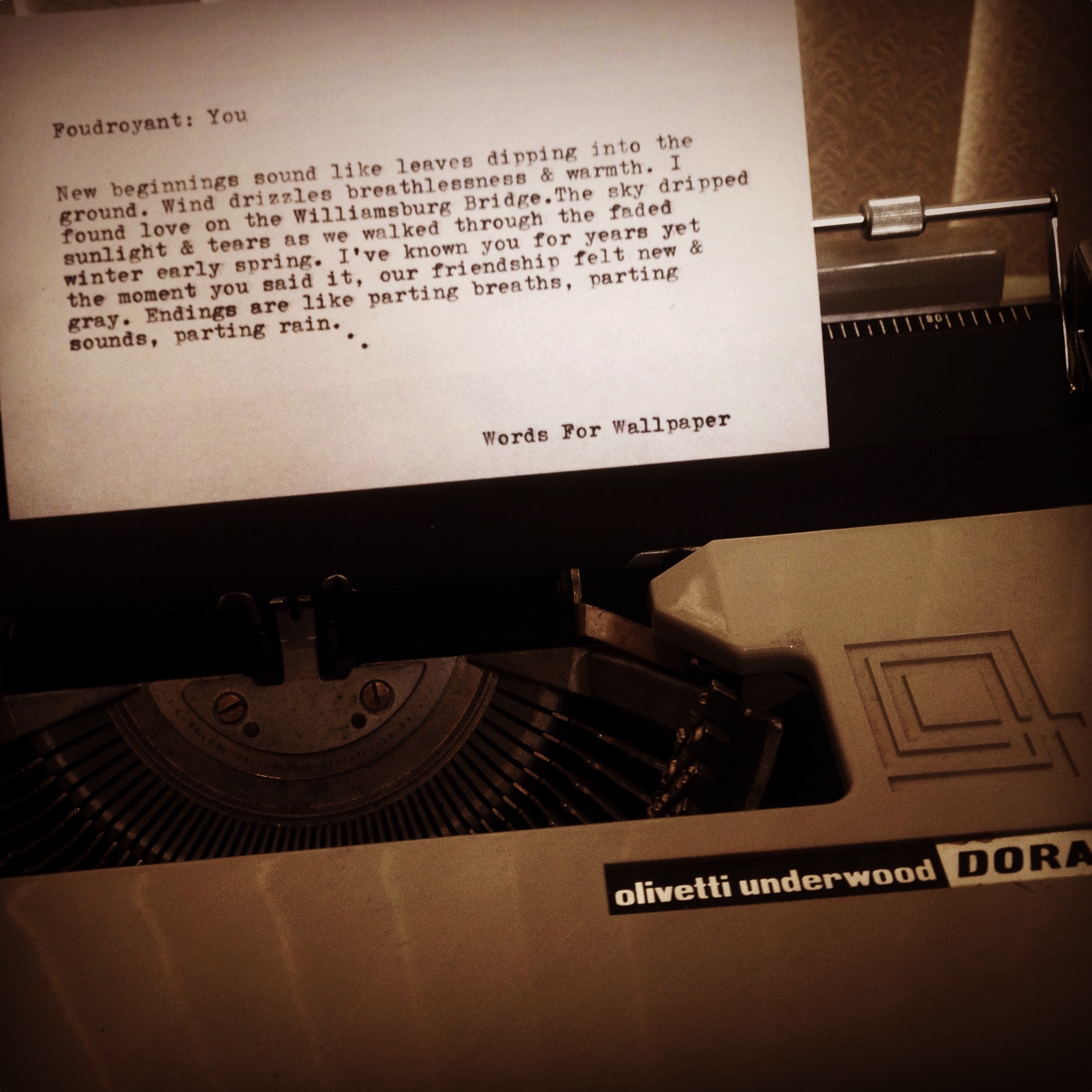Week 2: Much of Art is Waiting, Much of Writing is Staring
Bretty Rawson
For Week Two, we sat down a thousand miles away from Andrea Rehani and asked her about the origin, spirit, and plans for Words for Wallpaper.
HANDWRITTEN: What is the origin story of Words for Wallpaper? How did it emerge, and what was its genesis? Or, if there was a WikiHow site on your project, how many steps would there be, and what were they?
ANDREA REHANI: Words for Wallpaper branched off of the concept behind Poems While You Wait. Before I became a member, I was an enthusiastic customer. I was in a coffee shop with my sister and we were brainstorming creative writing ideas. I remember saying something like, “I want poetry to be framed like photographs.” Then, my sister came up with the name. Like Poems While You Wait, people give me random topics and then I produce an original poem. Unlike Poems While You Wait, it’s not done on the spot. Sometimes, the poem takes a few days to make.
The project is to get people excited about poetry. I don’t think you have to be a poet to enjoy a poem. I also feel personalized poems are special. It’s pretty rad to see people excited about writing – especially poetry. There’s this notion that poetry is as scary as math word problems or it needs to be something that is impossible to understand. I remember one of my first poetry classes with Kathleen and she wrote on the board, “Poetry must be as well written as prose. –Ezra Pound” I believe in this statement. Kathleen has taught me how to analyze the dramatic situation of a poem. She taught me to consider: who is speaking, to whom, and under what circumstances?
When I compose a poem, I still use those questions. I also consider form and content to communicate an image, a thought, or a memory. Form is structure; it can mean language, style, patterns, or the actual form of a poem. Content is meaning; it can mean characters, emotions, ideas, or tone.
HW: Does your project have a mission statement, or guiding phrase that governs its spiritual space?
AR: I suppose my mission for W4W is to not only get people stoked about poetry, but also make it accessible for anyone. My mother and I exchange handwritten letters and I hate how many people don’t anymore. I love getting mail - especially thoughtful letters. I have had a pen pal for two years and we exchanged handwritten letters. The mission is also to make handmade art. My favorite type of poetry is prose poetry. The poems I produce are in this form. I love writing in a hybrid genre – it’s something that still is unexpected. Paragraphs seem familiar but are tweaked in prose poetry – they alter a familiar structure.
HW: Tell us a little bit about your experiences with the project. The topics you've received, the challenges you have encountered.
AR: I started W4W by asking friends for topics. I asked readers and artists. At first I was a little nervous because I wanted to create something perfect for my friends. Then I realized there is beauty in imperfections. Creating something perfect isn’t what Words For Wallpaper is about – it’s about experimenting, understanding, and building. Like all handmade items, I want to create something unusual and unique. It’s unique to frame poetry, an image, a picture told in words.
These topics serve as writing prompts or exercises for me. I’ve written poems on topics of love, anniversary, twinkle lights, teeth, doppelganger, cacti, being in the woods at dusk, and the unknown. The hardest topics for me were love and anniversary. I knew they were gifts and they had to be extra personal. I’ve noticed personalized poems attract people. Writing is a means of communication. To gift a poem has a thoughtful intention. I want my poems to be just as thoughtful. It’s interesting to see non-poets associate thoughtfulness with poetry.
HW: Say Words for Wallpaper is a car, and its night. It has its headlights on, and so you, and us, know where it's headed, but even high beams fade like quicksand in the night. Do you have a destination in mind for Words for Wallpaper? Where is the project heading? Or, what's the next turn? Or, are you not concerned with what is beyond the bend for now?
AR: I eventually want to hand-make my own frames. One ideas includes using the hard covers of books to make a frame. Another is creating a black-out poetry frame. This would entail taking any form of writing (such as an article, poem, piece of prose, etc) and blacking out certain words to create a revised and new poem. I like the idea of a poem within a poem.
HW: Tell us about the name and how it relates to the typewriter, frames, still-words, and motion-images. Basically, tell us about the intersection between mental and physical realms of poetry, people, and expression.
AR: Wallpaper, art, typewriters, quotes are all used as a means for decoration. But, I don’t want my art to be pretty or just decorative; I want it to make you think. I like typing on a typewriter because it makes me think harder. I can’t look something up on the Internet. I have to rely on myself. Much of art is waiting. Much of writing is staring. The name is meant for decoration but there’s a duality. Decoration is associated with identity, personality, and choice. I wanted my name to encompass all of these ideas.
HW: How can someone get Words on their Wallpaper?
AR: If you are interested in a poem, send me a poem topic at WordsForWallpaper@gmail.com. I will mail you the poem.





